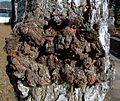Canker
Appearance
butternut
trees, and has no cure.A plant canker is a small area of dead tissue, which grows slowly, often over years. Some cankers are of only minor consequence, but others are ultimately lethal and therefore can have major economic implications for
bacteria, mycoplasmas and viruses. The majority of canker-causing organisms are bound to a unique host species or genus, but a few will attack other plants. Weather (via frost or windstorm damage) and animal damage can also cause stress to the plant resulting in cankers. Other causes of cankers is pruning when the bark is wet or using un-sterilized tools.[1]
Although fungicides or bactericides can treat some cankers, often the only available treatment is to destroy the infected plant to contain the disease.
Examples

- Neonectria galligena
- Ash bacterial canker, now understood to be caused by the bacterium Pseudomonas savastanoi, rather than Pseudomonas syringae. After DNA-relatedness studies Pseudomonas savastanoi has been instated as a new species.[2]
- Sirococcus clavigignenti-juglandacearum
- Bleeding canker of horse chestnut, caused by the bacterium Pseudomonas syringae pv. aesculi
- Xanthomonas axonopodis
- Cypress canker, caused by the fungus Seiridium cardinale
- Geosmithia putterillii
- Dogwood anthracnose, caused by the fungus Discula destructiva
- Grape canker, caused by the fungus Eutypa lata
- Honey locust canker, caused by the fungus Thyronectria austro-americana
- Larch canker, caused by the fungus Lachnellula willkommii
- Mulberry canker, caused by the fungus Gibberella baccata
- Diplodia quercina
- Pine pitch canker, caused by the fungus Fusarium circinatum
- Plane anthracnose, caused by the fungus Apiognomonia veneta
- Poplar canker, caused by the bacterium Xanthomonas populi
- blackleg fungus Leptosphaeria maculans
- Rose cankers, caused by the fungus Leptosphaeria coniothyrium and Cryptosporella umbrina
- Gremmeniella abietina
- Southwest canker, caused by environmental conditions (frost damage and sun-scalding)[3]
- Tomato anthracnose, caused by the fungus Colletotrichum coccodes
- Marssonina salicicola
-
Canker on a birch
-
Canker on a beech tree
-
Canker on an ash tree in North Ayrshire, Scotland
See also
References
- ^ "Canker Diseases". The Morton Arboretum. Retrieved 18 September 2023.
- PMID 10319466.
- ^ Southwest Canker
- ^ Smith, B. J. (2007). "Developmental Stage and Temperature Affect Strawberry Flower and Fruit Susceptibility to Anthracnose". In Takeda, F.; Handley, D. T.; Poling, E. B. (eds.). Proceedings 2007 North American Strawberry Symposium. Kemptville, ON Canada: North American Strawberry Growers Association. pp. 55–57.
- S2CID 219479598.
- PMID 23136458.
External links
Wikimedia Commons has media related to Canker.
- [1] Canker Diseases of Trees



